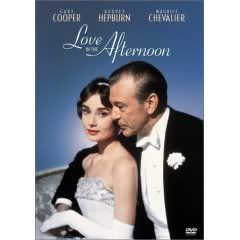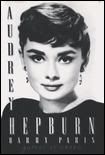Audrey Hepburn Collection
One of my recent pet purchase was a Audrey Hepburn Box Set. It contains 19 of her films; The Lavender Hill Mob (1951), Roman Holiday (1953), Sabrina (1954), Funny Face (1957), Love in the Afternoon (1957), Green Mansions (1959), The Nun's Story (1959), The Unforgiven (1960), Breakfast at Tiffany's (1961), The Children's Hour (1961), Charade (1963), Paris-When it Sizzles (1964), My Fair Lady (1964), How to Steal a Million (1966), Wait Until Dark (1967), Two for the Road (1967), War and Peace (1972), Robin and Marian (1976) and Always (1989) and a bonus soundtrack from Breakfast at Tiffany's.

Granted, I have before the purchase seen more than half of her films, but it is a wonderful feeling to own a complete collection packaged beautifully.
I indulged in Love in the Afternoon last Thurs. Hmmm.... all I can say is Audrey Hepburn's never dissapointed me as yet...

Anecdotes from http://www.audrey1.com/films/love.html
Based on a popular novel by Claude Anet set in pre-Bolshevik Russia, the story had the ring of Gigi and Sabrina: sophisticated Don Juan falls for innocent young beauty. It was reworked by Wilder and I. A. L. Diamond-the first of their legendary script collaborations to make the playboy even more cynical and the girl even more naive: Ariane became the cellist-daughter of a private detective and would fall in love with the rich libertine being investigated by her father for marital infidelity. The mise-en-scène was shifted from Russia to Paris, and the title spiced up to Love in the Afternoon.
Wilder tried to get Cary Grant as Audrey's costar, but he considered himself too mature to play romantic scenes with a woman in her twenties - one of the reasons he had turned down the Bogart role in Sabrina. The solution was Gary Cooper, despite being older than Grant, seemed unconcerned about the twenty-eight-year age gap with his leading lady. Wilder's solution to the problem was to frequently keep Cooper in the shadows, with the result that few of the movie's stills highlight Cooper, while Audrey positively glows in the prime of her youthful beauty.
According to Barry Paris, "Hepburn was filmed to perfection by William Mellor (A Place in the Sun). The final "farewell" scene, with Cooper scooping her up into a moving train in fine cowboy fashion, is a classic. But audiences and critics alike had trouble accepting The Age Gap. Despite the aid of gauzy filters, Cooper still looked old enough to be her father, which made the plot look more like a tawdry affair than a romance. It was "among the bleakest, most melancholy of comedies," said American Film. "Cooper's face is often in silhouette, making it appear that Hepburn has fallen in love with a shadow. Which, in essence, she has." To thwart charges of bad taste and bad morals, a voice-over was added at the end, assuring viewers that they were headed for the altar. Even so, in Spain several scenes were censored, and in France its name reverted to Ariane because the American title was considered too suggestive."
And after reading Wayne Koestenbaum's article in the London Review of Books, I am now including Audrey Hepburn by Barry Paris in my Wish List....


Granted, I have before the purchase seen more than half of her films, but it is a wonderful feeling to own a complete collection packaged beautifully.
I indulged in Love in the Afternoon last Thurs. Hmmm.... all I can say is Audrey Hepburn's never dissapointed me as yet...

Anecdotes from http://www.audrey1.com/films/love.html
Based on a popular novel by Claude Anet set in pre-Bolshevik Russia, the story had the ring of Gigi and Sabrina: sophisticated Don Juan falls for innocent young beauty. It was reworked by Wilder and I. A. L. Diamond-the first of their legendary script collaborations to make the playboy even more cynical and the girl even more naive: Ariane became the cellist-daughter of a private detective and would fall in love with the rich libertine being investigated by her father for marital infidelity. The mise-en-scène was shifted from Russia to Paris, and the title spiced up to Love in the Afternoon.
Wilder tried to get Cary Grant as Audrey's costar, but he considered himself too mature to play romantic scenes with a woman in her twenties - one of the reasons he had turned down the Bogart role in Sabrina. The solution was Gary Cooper, despite being older than Grant, seemed unconcerned about the twenty-eight-year age gap with his leading lady. Wilder's solution to the problem was to frequently keep Cooper in the shadows, with the result that few of the movie's stills highlight Cooper, while Audrey positively glows in the prime of her youthful beauty.
According to Barry Paris, "Hepburn was filmed to perfection by William Mellor (A Place in the Sun). The final "farewell" scene, with Cooper scooping her up into a moving train in fine cowboy fashion, is a classic. But audiences and critics alike had trouble accepting The Age Gap. Despite the aid of gauzy filters, Cooper still looked old enough to be her father, which made the plot look more like a tawdry affair than a romance. It was "among the bleakest, most melancholy of comedies," said American Film. "Cooper's face is often in silhouette, making it appear that Hepburn has fallen in love with a shadow. Which, in essence, she has." To thwart charges of bad taste and bad morals, a voice-over was added at the end, assuring viewers that they were headed for the altar. Even so, in Spain several scenes were censored, and in France its name reverted to Ariane because the American title was considered too suggestive."
And after reading Wayne Koestenbaum's article in the London Review of Books, I am now including Audrey Hepburn by Barry Paris in my Wish List....



0 Comments:
Post a Comment
<< Home